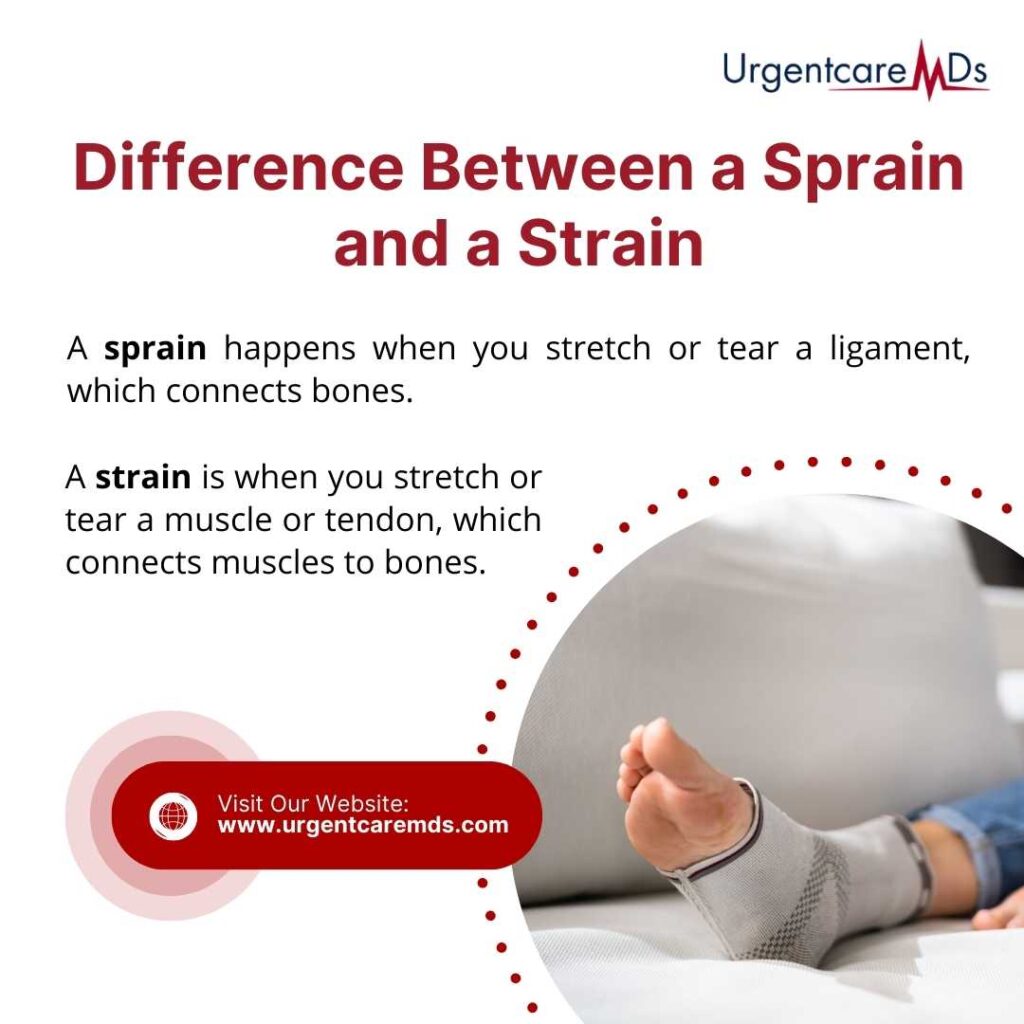Sprains and Strains: Where Should I Go for Care?
When you twist your ankle or strain a muscle, it’s important to know where to go for help. Should you visit the emergency room, see your primary care doctor, or go to urgent care?
Choosing the right place can save you time and money while ensuring you get the care you need. Let’s dive into some common questions about sprains and strains, and help you make the best decision.
What’s the Difference Between a Sprain and a Strain?
Sprains and strains are common injuries, but they affect different parts of the body.
- Sprains happen when the ligaments, which connect bones to each other, stretch or tear. This is most common in joints like the ankle, wrist, or knee.
- Strains involve the muscles or tendons, which connect muscles to bones. This injury is often caused by overstretching or tearing these tissues, commonly affecting the back, legs, or arms.
Both injuries can be painful and limit movement, but sprains tend to cause swelling and bruising, while strains often lead to muscle spasms or weakness.

How Do I Know If It’s a Serious Injury?
Not all sprains and strains need immediate medical care, but it’s important to know when it’s time to see a healthcare professional.
- Minor injuries: If you can still move the injured area and the pain is manageable, you might just need rest, ice, compression, and elevation (R.I.C.E.).
- Serious injuries: If you can’t put weight on the injury, hear a popping sound at the time of injury, or notice severe swelling, bruising, or numbness, you should see a doctor. In these cases, it’s possible you’ve torn a ligament or muscle, which may need more than home care.
Should I Go to the Emergency Room?
The emergency room (ER) is the right choice for life-threatening injuries. But for sprains and strains, it’s usually not necessary unless the injury is extremely severe.
Go to the ER if:
- There’s a visible deformity, such as a bone sticking out.
- You experience uncontrollable bleeding or suspect a broken bone.
- You can’t move the affected limb at all.
In these cases, quick care is crucial. But if you have a sprain or strain that isn’t critical, another option might be more convenient.
When Should I Visit an Urgent Care Center?
If your injury is painful and swollen but doesn’t seem severe, urgent care is an excellent option. Urgent care centers can treat sprains and strains, and they often have shorter wait times than the ER. They also cost less and provide X-rays, so they can check for fractures or other serious issues on the spot.
Visit an urgent care center if:
- You’re in pain, but the injury doesn’t appear life-threatening.
- You need an X-ray to confirm if there’s a fracture.
- Your injury happened outside of regular doctor’s office hours.
An Urgent care clinic is a smart choice when you need quick help, but it’s not an emergency.
Can My Primary Care Doctor Help?
Your primary care doctor (PCP) is a good resource for many injuries, including sprains and strains. If you’ve had the injury for a few days and it’s not getting better, your doctor can evaluate you and help create a treatment plan.
See your primary care doctor if:
- You’ve already tried home treatments, but your pain isn’t improving.
- You want to check if physical therapy or other long-term care is needed.
- Your injury isn’t urgent, but you need professional advice.
Your PCP can guide your recovery for ongoing issues or less severe sprains and strains.
What Treatment Will I Receive for a Sprain or Strain?
The treatment for sprains and strains varies depending on the severity of the injury.
Mild injuries
Rest, ice, compression, and elevation are usually enough. Over-the-counter pain relief, like ibuprofen, can also help.
Moderate to severe injuries
Your healthcare provider may recommend a brace or splint to stabilize the injury. In some cases, physical therapy may be necessary to regain strength and flexibility. If a ligament or muscle is torn, surgery could be required, though this is less common.
In all cases, follow-up care is important to ensure the injury heals correctly and doesn’t lead to long-term problems.
How Long Does It Take to Heal?
Healing times for sprains and strains depend on the severity of the injury and your overall health.
- Mild sprains/strains: These can heal in one to two weeks with proper care.
- Moderate injuries: Expect recovery to take up to six weeks.
- Severe injuries: Healing may take several months, especially if surgery is involved.
It’s important not to rush the recovery process. Returning to physical activity too soon can lead to re-injury or long-term damage.

How Can I Prevent Future Injuries?
Once you’ve recovered, taking steps to avoid future sprains and strains is key.
- Warm up before exercise or physical activity to get your muscles ready.
- Strengthen your muscles with regular exercise to support your joints.
- Wear proper footwear to provide stability, especially during sports or physical work.
- Use good form when lifting heavy objects or working out to reduce the risk of overextending your muscles.
Preventing future injuries is possible with the right approach and care.
What Should I Do If I Need X-Rays or More Advanced Care?
Sometimes, sprains and strains require further testing, like X-rays, to rule out fractures or other complications. If you suspect a more serious injury, urgent care centers can often provide these services on-site, saving you a trip to the hospital.
If your primary care doctor doesn’t offer X-rays, or you need immediate care, urgent care is a great option. Many urgent care centers are equipped to handle these situations, so you can get a diagnosis and treatment plan quickly.
When Should I Seek Professional Help for My Injury?
Sprains and strains are common but can be painful and disruptive. Knowing where to go for care is crucial to get back on your feet faster. Whether you choose to visit urgent care, the emergency room, or your primary care physician, the most important thing is to seek the right care at the right time.
For fast and reliable help, consider visiting Urgent Care MDs for your next sprain or strain. We’re here to support your recovery and keep you moving forward.

Why Choose Urgent Care MDs?
At Urgent Care MDs, we offer fast, reliable care for sprains, strains, and many other non-life-threatening injuries. Whether you look for “urgent care near me”, need an X-ray, pain relief, or advice on managing your injury, we’re here to help.
With multiple locations, including:
we’re closeby when you need us most. Our staff provides high-quality care with a focus on convenience and affordability.
If you’re looking for a primary care physician in Baytown, TX, we can also help connect you with one.
For injuries needing more advanced treatment, like an Urgent Care with X-ray, Urgent Care MDs have you covered. Don’t wait in long ER lines—visit us today and get the care you deserve.
***
The material contained on this site is for informational purposes only and DOES NOT CONSTITUTE THE PROVIDING OF MEDICAL ADVICE, and is not intended to be a substitute for independent professional medical judgment, advice, diagnosis, or treatment. Always seek the advice of your physician or other qualified healthcare provider with any questions or concerns you may have regarding your health.

